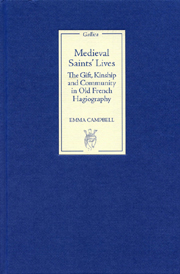5 - Textual Community
from Community
Published online by Cambridge University Press: 05 February 2013
Summary
If we want to imagine […] that the oppressed subject gains agency by means of identifications with others who elude resemblance, let us imagine the widest possible usable field of others with whom to make such partial connections. Let us imagine a process that engages all kinds of differences, though not all in the same ways […]. Thus […] the medieval, as well as other dank stretches of time, becomes itself a resource for subject and community formation and materially engaged coalition building. By using this concept of making relations with the past we realize a temporal dimension of the self and of community.
(Dinshaw, Getting Medieval, p. 21.)This chapter is concerned with community: that is, community as an imaginary and always ideological relationship to others. It is also concerned with the role that medieval texts might have played in creating a sense of community in the world outside them. As both this and the next chapter will demonstrate, these are themes with which vernacular saints' lives are very much concerned. The formation and confirmation of Christian community is axiomatic to the hagiographic project as a whole and, in some vernacular Lives, provokes reflection on the processes that contribute to this important textual and extra-textual function. It is not just medieval hagiographers who are interested in such issues, however. As indicated by the above quotation, questions of community have currency in debates taking place in medieval studies, as elsewhere. In a postmodern universe where God is dead (or unconscious), issues of identification, resemblance and connectivity have become fraught but nonetheless urgent and anxiously debated concerns.
- Type
- Chapter
- Information
- Medieval Saints' LivesThe Gift, Kinship and Community in Old French Hagiography, pp. 121 - 148Publisher: Boydell & BrewerPrint publication year: 2008



